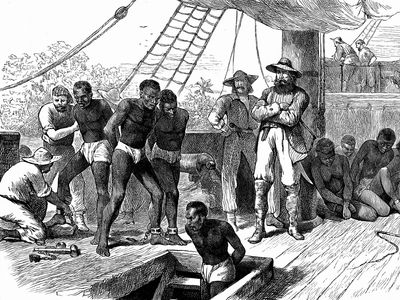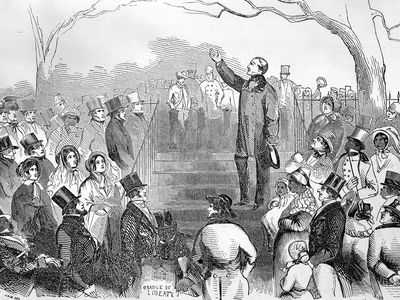TRANSATLANTIC SLAVE TRADE OF AFRICANS (Full History)
Transatlantic slave trade is a segment of the global slave trade that transported between 10 million and 12 million enslaved Africans across the Atlantic Ocean to the Americas from the 16th to the 19th century. It was the second of three stages of the so-called triangular trade, in which arms, textiles, and wine were shipped from Europe to Africa, enslaved people from Africa to the Americas, and sugar and coffee from the Americas to Europe.

By the 1480s Portuguese ships were already transporting Africans as enslaved labourers on the sugar plantations in the Cape Verde and Madeira islands in the eastern Atlantic. Spanish conquistadors took enslaved Africans to the Caribbean after 1502, but Portuguese merchants continued to dominate the transatlantic slave trade for another century and a half, operating from their bases in the Congo-Angola area along the west coast of Africa. The Dutch became the foremost traders of enslaved people during parts of the 1600s, and in the following century English and French merchants controlled about half of the transatlantic slave trade, taking a large percentage of their human cargo from the region of West Africa between the Sénégal and Niger rivers. In 1713 an agreement between Spain and Britain granted the British a monopoly on the trade of enslaved people with the Spanish colonies. Under the Asiento de negros, Britain was entitled to supply those colonies with 4,800 enslaved Africans per year for 30 years. The contract for this supply was assigned to the South Sea Company, of which British Queen Anne held some 22.5 percent of the stock.
Probably no more than a few hundred thousand Africans were taken to the Americas before 1600. In the 17th century, however, demand for enslaved labour rose sharply with the growth of sugar plantations in the Caribbean and tobacco plantations in the Chesapeake region in North America. The largest numbers of enslaved people were taken to the Americas during the 18th century, when, according to historians’ estimates, nearly three-fifths of the total volume of the transatlantic slave trade took place.

The slave trade had devastating effects in Africa. Economic incentives for warlords and tribes to engage in the trade of enslaved people promoted an atmosphere of lawlessness and violence. Depopulation and a continuing fear of captivity made economic and agricultural development almost impossible throughout much of western Africa. A large percentage of the people taken captive were women in their childbearing years and young men who normally would have been starting families. The European enslavers usually left behind persons who were elderly, disabled, or otherwise dependent—groups who were least able to contribute to the economic health of their societies.
Historians have debated the nature and extent of European and African agency in the actual capture of those who were enslaved. During the early years of the transatlantic slave trade, the Portuguese generally purchased Africans who had been enslaved during tribal wars. As the demand for enslaved people grew, the Portuguese began to enter the interior of Africa to forcibly take captives; as other Europeans became involved in the slave trade, generally they remained on the coast and purchased captives from Africans who had transported them from the interior. Following capture, the abducted Africans were marched to the coast, a journey that could be as many as 300 miles (485 km). Typically, two captives were chained together at the ankle, and columns of captives were tied together by ropes around their necks. An estimated 10 to 15 percent of the captives died on their way to the coast.
The Middle Passage
The Atlantic passage, or Middle Passage, usually to Brazil or an island in the Caribbean, was notorious for its brutality and for the overcrowded unsanitary conditions on slave ships, in which hundreds of Africans were packed tightly into tiers below decks for a voyage of about 5,000 miles (8,000 km) that could last from a few weeks to several months.
They were typically chained together, and usually the low ceilings did not permit them to sit upright. The heat was intolerable, and the oxygen levels became so low that candles would not burn. Because crews feared insurrection, the Africans were allowed to go outside on the upper decks for only a few hours each day. Historians estimate that between 15 and 25 percent of the enslaved Africans bound for the Americas died aboard slave ships. Death rates, which were directly proportional to the length of the voyage, declined as the time of the voyage was reduced significantly between the beginning of the 16th century and the end of the 19th century.The autobiographical account of the West African Olaudah Equiano, published in 1789, is particularly well known for its graphic descriptions of the suffering endured on the transatlantic voyages.
Abolishment of Slave Trade
Joseph Cinqué, leader of the revolt aboard the slave ship Amistad; from a broadside dated 1839.
Atrocities and sexual abuse of the enslaved captives were widespread, although their monetary value as slaves perhaps mitigated such treatment. Ship captains could not ignore the health of their human cargo, because they were paid only for enslaved persons delivered alive. Moreover, the death rates among the European captains and crew engaged in the trade of enslaved people were at least as high as those among their captives on the Middle Passage. In an infamous incident on the slave ship Zong in 1781, when both Africans and crew members were dying of an infectious disease, Capt. Luke Collingwood, hoping to stop the disease, ordered that more than 130 Africans be thrown overboard. He then filed an insurance claim on the value of the murdered enslaved persons. Occasionally, the African captives successfully revolted and took over the ships. The most famous such incident occurred when in 1839 a slave named Joseph Cinqué led a mutiny of 53 illegally purchased enslaved people on the Spanish slave ship Amistad, killing the captain and two members of the crew. The U.S. Supreme Court eventually ordered the Africans to be returned to their homes.
Banning the trade of enslaved people
At the time of the American Revolution (1775–83), there was widespread support in the Northern American colonies for prohibiting the importation of more enslaved people. However, after the Revolution, at the insistence of Southern states, Congress waited more than two decades before making the importation of enslaved people illegal. When Congress did so, in 1808, the law was enacted with little dissent, but Caribbean smugglers frequently violated the law until it was enforced by the Northern blockade of the South in 1861 during the American Civil War.
After Great Britain outlawed slavery throughout its empire in 1833, the British navy diligently opposed the trade of enslaved people in the Atlantic and used its ships to try to prevent slave-trading operations. Brazil outlawed the trade of enslaved people in 1850, but the smuggling of newly enslaved persons into Brazil did not end entirely until the country finally enacted emancipation in 1888.

